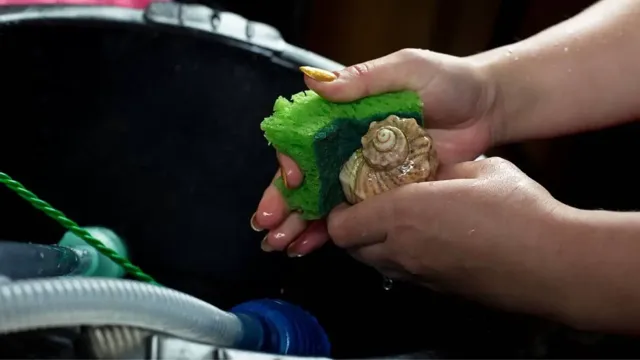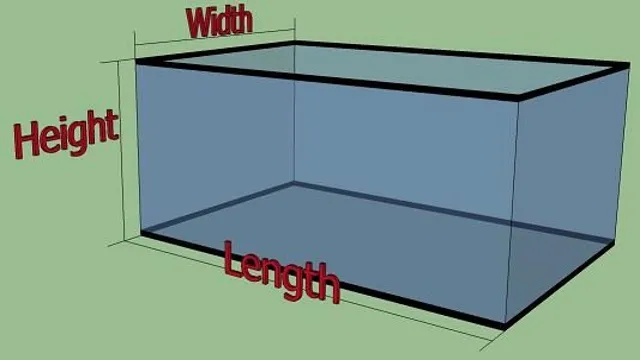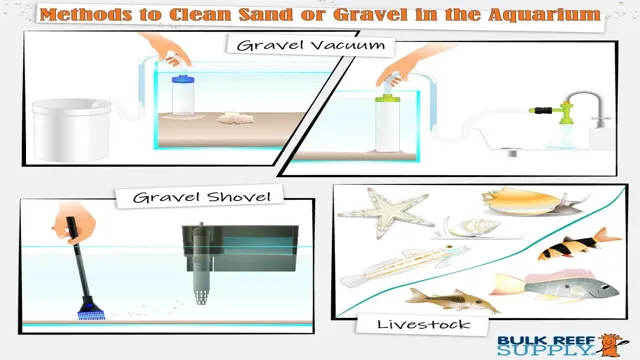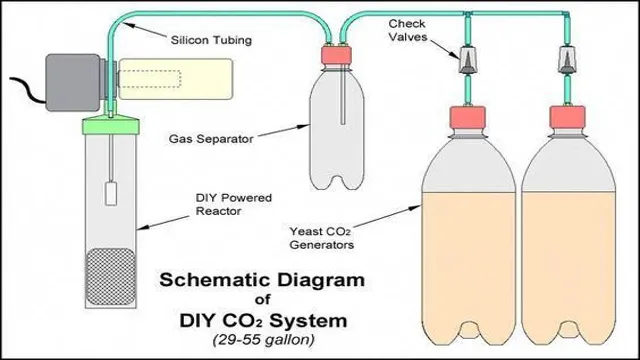Have you ever noticed unsightly algae growing on your aquarium wood? Not only is it an eyesore, but it can also harm the health of your aquatic pets. If you’re wondering how to clean algae from aquarium wood, you’re in the right place! Algae can quickly colonize on wood, and the longer it’s left untreated, the more difficult it becomes to remove. The good news is, with the right tools and a little patience, you can easily remove algae and restore your aquarium wood to its former beauty.
So, let’s dive in and explore the best methods for tackling that pesky algae on your aquarium wood!
What Causes Algae to Grow on Aquarium Wood?
If you’ve noticed freshwater aquarium wood covered in algae, you’re not alone. Algae growth on aquarium wood is a common problem that many aquarium owners face. Algae growth is caused by a combination of factors, including too much light and excess nutrients in the water.
This is because algae require light and nutrients, such as nitrate and phosphate, to grow. To clean algae from your aquarium wood, the first step is to remove any excess algae from the wood using a soft-bristled brush or toothbrush. You can also try wiping the wood down with a damp cloth to further remove any remaining algae.
To prevent future algae growth, consider reducing the amount of light your aquarium receives and monitor the nitrate and phosphate levels in the water. Additionally, adding live plants to your aquarium can help compete with algae for nutrients, thus reducing the likelihood of algae growth. By taking these steps, you can keep your aquarium wood clean and healthy.
Excess Light and Nutrient Build-up
Algae growth on aquarium wood can be caused by excess light and nutrient build-up. Algae can be a common problem in aquariums, and can be caused by several factors. One of the main factors is excess light, which can promote the growth of algae.
If your aquarium is placed in a location with too much natural light or you have aquarium lights on for too long, this can trigger algae growth. Another factor is nutrient build-up, which is caused by overfeeding or inadequate filtration. When there are too many nutrients in the water, algae can thrive and quickly grow.
To prevent algae growth on aquarium wood, it is important to monitor lighting and nutrient levels, and ensure proper filtration. Regular water changes and keeping a healthy balance of fish and plants can also prevent excess nutrients in the water. Taking these steps can help keep your aquarium looking clear and healthy, without the unsightly presence of algae.

Inadequate Water Circulation and Filtration
One of the main causes of algae growth on aquarium wood is inadequate water circulation and filtration. When there is not enough water movement or the filtration system is not functioning properly, algae can thrive on any surface in the aquarium, including wood. Algae needs nutrients to grow, and if there are excess nutrients in the water due to poor circulation or filtration, it can lead to an overgrowth of algae.
Additionally, stagnant water can create low-oxygen areas where anaerobic bacteria can flourish and release even more nutrients into the water, creating a vicious cycle. To combat this, make sure to properly maintain the aquarium’s filtration system and consider adding a powerhead or additional pump to enhance water movement. By keeping the water flowing and clean, you can help prevent algae growth on your aquarium wood and maintain a healthy environment for your aquatic pets.
Tools Needed to Clean Algae from Aquarium Wood
Cleaning algae from aquarium wood is an important part of maintaining a healthy and visually pleasing aquarium. To get the job done, you’ll need a few tools. First up, a reliable algae scraper is a must-have.
Choose one that won’t scratch the surface of your wood or tank, such as a soft-bristle brush, sponge or scraper with a plastic edge. A pair of aquarium scissors will also come in handy to trim any larger, tougher patches of algae that resist scrubbing. A gravel vacuum can be used to suck up loose algae particles and debris that you dislodge from the wood.
Additionally, a strong and effective aquarium filter will help keep the water clean and clear of algae in the first place. With these tools at your disposal, you’ll be able to effectively remove algae from your aquarium wood and keep your fish tank looking its best.
Soft-bristled Brush
When it comes to cleaning algae from aquarium wood, you need to have the right tools if you want to ensure thorough cleaning without damaging the wood in your tank. A soft-bristled brush is a must-have tool for this task, as it allows you to scrub away any algae buildup without scratching or scuffing the wood surface. The gentle bristles are effective at removing algae without being too abrasive, which can harm the delicate wood material.
Make sure to use a brush with fine, natural bristles that won’t fray or break off during use. With a soft-bristled brush in hand, you’ll be able to tackle algae buildup on your aquarium wood quickly and easily, keeping your tank looking clean and healthy for your fish to enjoy.
Algae Scraper
Algae scraper Keeping your aquarium wood clean and free of algae is crucial for the health and longevity of your aquatic animals. Algae builds up easily and can be tough to remove. Fortunately, there are a few tools that can make the process easier. (See Also: How to Make Oxygen for Fish Aquarium: Simple DIY Solutions)
One such tool is an algae scraper, also known as an algae magnet. This device is essentially a small scraper attached to a handle with a magnet on the other end. To use it, simply place the magnet on the outside of the aquarium and then move the scraper back and forth on the inside of the glass.
The magnetic force holds the scraper in place and allows you to easily remove any buildup. Algae scrapers are available in various sizes and shapes, so make sure to choose one that suits the size and shape of your aquarium. With consistent use of an algae scraper, you can ensure your aquarium wood looks pristine and your aquatic animals remain healthy.
Aquarium Vacuum Cleaner
Cleaning algae from aquarium wood can be a hassle, but the right tools can make it a breeze. One essential tool to have in your aquarium cleaning arsenal is an aquarium vacuum cleaner. This handy device not only removes algae and other debris from your aquarium wood, but it also helps to remove waste and excess food that may have accumulated on the substrate.
Another tool that can be helpful is a soft-bristled brush, which gently loosens any stubborn algae that may be clinging to the wood. When using a brush, be sure to avoid scratching the wood or disturbing any live plants or animals that may be inhabiting your aquarium. With the right tools and a little bit of elbow grease, you can keep your aquarium wood clean and healthy for your aquatic pets to enjoy.
Step-by-Step Guide to Cleaning Algae from Aquarium Wood
Are you tired of algae taking over your aquarium wood and making it look unsightly? Don’t worry, we’ve got you covered with this step-by-step guide on how to clean algae from aquarium wood. First, remove the wood from the aquarium and give it a thorough rinse with warm water. Next, use a soft-bristled brush to scrub away any visible algae, being careful not to scratch the wood’s surface.
If the algae is stubborn, you can try using a dilute bleach solution, but be sure to rinse the wood thoroughly afterwards to avoid harming your fish. Finally, let the wood dry completely before returning it to the aquarium. With a little patience and elbow grease, your aquarium wood will be algae-free in no time!
Remove the Wood from the Aquarium
Cleaning algae from aquarium wood can be a daunting task, especially if you’re new to the hobby. However, it’s essential to remove algae buildup from the wood to keep your aquarium healthy and looking its best. The first step in the process is to remove the wood from the aquarium carefully.
You can do this by turning off all equipment connected to the tank, including the filter and heater. Then, unplug the electrical cords and hoses and carefully lift the wood out of the aquarium, making sure not to damage any plants or other decorations. Once you’ve removed the wood, you’ll need to clean it thoroughly using a soft-bristled brush or sponge and warm, soapy water.
Rinse the wood thoroughly with clean water to remove any remaining soap residue. It’s essential to be gentle while cleaning aquarium wood to prevent any damage to the wood’s surface, and ensure you don’t accidentally hurt any fish living in the aquarium. Proper cleaning of aquarium wood will keep your fish healthy and happy, and add an aesthetic touch to your aquarium.
Clean the Wood with a Soft-bristled Brush
Cleaning algae from aquarium wood can be a daunting task, especially if you are new to this hobby. However, it is essential to keep the wood clean to maintain a healthy environment for your fish and other aquatic creatures. One of the first steps to cleaning the algae from the aquarium wood is by using a soft-bristled brush.
This type of brush is gentle enough not to scratch the wood’s surface, but it’s effective enough to remove any dirt or algae buildup. You can start by removing any debris or large algae patches with your hands and then use the brush to clean the rest. Be sure to cover every inch of the wood to eliminate any buildup that could cause harm to your aquatic pets.
By taking this step, you ensure that your aquarium remains clean and tidy, keeping your fish healthy and happy.
Scrape Off Stubborn Algae with an Algae Scraper
Cleaning algae from aquarium wood can be a challenge, but with an algae scraper, it becomes less daunting. Step 1 is to remove any floating debris and plants from the wood and the surrounding area. Then, use the scraper to gently remove the algae, starting from the top and working your way down.
Be careful not to use too much force, especially if the wood is fragile. If there are still some stubborn spots, try using a soft-bristled brush or toothbrush to gently work the algae off. Step 2 is to rinse the wood thoroughly with clean water to remove any remaining algae or debris.
You may want to repeat the process if necessary. Finally, step 3 is to add your plants and decorations back into the tank and enjoy your clean and beautiful aquarium wood. Using an algae scraper is a great way to keep your aquarium healthy and looking its best.
Vacuum the Area Around the Wood with an Aquarium Vacuum Cleaner
If you have a wooden decoration in your aquarium, chances are that over time, algae will start to grow on it. This can be a bit tricky to deal with, but don’t worry – by following a few simple steps, you can easily get rid of it. The first thing you’ll need to do is to vacuum the area around the wood with an aquarium vacuum cleaner. (See Also: How to Find the Volume of Aquarium: Essential Tips and Tricks)
This will remove any loose algae or debris and ensure that you’re starting with a clean surface. Next, use a soft-bristled brush to gently scrub the wood, being careful not to scrape or damage it. You can also use a toothbrush if you need to get into tighter spaces.
Once you’ve scrubbed the wood thoroughly, use a clean cloth to wipe away any remaining algae or debris. If the algae is particularly stubborn, you can dip the brush in hydrogen peroxide or bleach (diluted, of course) to help loosen it up. Just be sure to rinse the wood thoroughly with clean water afterwards.
By following these simple steps, you’ll have your aquarium wood looking clean and algae-free in no time!
Rinse the Wood Thoroughly with Dechlorinated Water
When it comes to cleaning algae from aquarium wood, it’s crucial to ensure you’re doing it in a way that won’t harm your fish or their habitat. One essential step in the process is rinsing the wood thoroughly with dechlorinated water. This helps to remove any remaining algae, as well as any debris or residue from the cleaning process.
But why dechlorinated water specifically? Chlorine is commonly found in tap water, and it can be harmful to fish. Using dechlorinated water removes this risk, ensuring that your fish remain safe and healthy. So, be sure to rinse your aquarium wood thoroughly with dechlorinated water after cleaning to ensure a healthy and happy environment for your fish.
Preventing Algae Growth on Aquarium Wood
If you’re noticing algae growth on your aquarium wood, there are a few steps you can take to prevent it from happening. Firstly, make sure you’re not overfeeding your fish or leaving excess food in the tank. This can contribute to algae growth.
Additionally, consider adding some algae-eating fish or snails to your tank to keep the algae at bay. When it comes to cleaning the algae off your wood, make sure you’re using a soft-bristled brush or cloth and avoid using any harsh chemicals or cleaners that could harm your fish. You can also try lowering the temperature of the water slightly, as algae tends to thrive in warmer temperatures.
By taking these steps, you can keep your aquarium wood looking clean and healthy for your underwater friends to enjoy.
Limit Excess Light and Nutrient Build-up
Preventing algae growth on aquarium wood can be a challenge for many aquarium owners, but there are a few things you can do to limit excess light and nutrient build-up. One easy way to limit light is by placing your aquarium away from direct sunlight or reducing the amount of time your aquarium light is on. This will help prevent excessive algae growth on your aquarium wood.
You can also limit nutrient build-up by performing regular water changes and cleaning your aquarium equipment, such as filters, to ensure they are working properly. Another helpful tip is to include aquatic plants in your aquarium, as they can help absorb excess nutrients and reduce algae growth. By implementing these strategies, you can keep your aquarium wood looking clean and healthy while minimizing algae growth.
Ensure Adequate Water Circulation and Filtration
If you have aquarium wood in your fish tank, you may notice algae growing on it. This can be unsightly and harmful to your fish if left unchecked. To prevent algae growth, it is crucial to ensure adequate water circulation and filtration in your aquarium.
Algae grow in stagnant water, so ensuring proper water flow will prevent its growth. You can achieve this by adding a high-quality filter system to your aquarium, or by simply increasing the flow rate of your current filter. Additionally, adding live plants to your tank can help absorb excess nutrients, preventing algae from taking hold.
By taking these steps, you can enjoy your aquarium wood without the worry of unsightly and potentially harmful algae growth.
Maintain Proper Water Parameters
If you’re wondering how to prevent algae growth on aquarium wood, one of the best things you can do is maintain proper water parameters. Algae tend to thrive in water that’s rich in nutrients such as nitrates and phosphates. By keeping a close eye on these levels and making sure they stay within a healthy range, you can help to minimize the growth of algae on your wood and other surfaces.
Additionally, it’s important to make sure you’re providing adequate filtration and circulation in your tank, as stagnant water can also contribute to the growth of algae. By taking these steps and regularly monitoring your water quality, you’ll be giving your aquarium wood the best chance to stay clean and healthy for your fish and other aquatic creatures to enjoy. (See Also: How to Kill String Algae in Aquarium: Tips and Tricks for a Clearer Tank Water)
Perform Regular Tank Maintenance
As a responsible aquarium owner, it’s important to perform regular tank maintenance to prevent algae growth on aquarium wood. Algae can be a common problem in aquariums, and it can quickly take over your wooden ornaments and fixtures if left unchecked. Firstly, it’s important to remove any excess food, debris, or waste from the tank regularly to minimize the nutrient levels in the water.
Secondly, you can limit the amount of light that filters into the tank as algae thrives in well-lit areas. You can also consider purchasing an algae-eating fish or snail to keep the growth under control. Finally, it’s recommended to scrub down the aquarium wood periodically to prevent algae buildup and maintain its appearance.
With these preventative measures in place, you can enjoy a clean and healthy aquarium for all to admire!
Conclusion
In conclusion, cleaning algae from aquarium wood may seem like a daunting task, but with a few simple steps, it can be easily tackled. Remember to identify the type of algae you are dealing with, remove any excess debris, and use a specialized algae scraper or brush. With a little bit of elbow grease, your aquarium wood will be sparkling clean in no time.
After all, a clean aquarium is a happy aquarium, and happy fish are the best kind of fish.”
FAQs
What causes algae to grow on aquarium wood?
Algae grows on aquarium wood when it gets exposed to excess light, nutrients, and moisture.
What are the effects of algae on aquarium wood?
Algae can make the aquarium wood look unsightly, and if left unchecked, it can cause wood rot and create a breeding ground for harmful bacteria and parasites.
How often should I clean algae off aquarium wood?
You should clean algae off aquarium wood as soon as you notice it. Depending on the growth rate of algae in your aquarium, you may need to do this every few weeks or months.
Is there a specific way to clean algae from aquarium wood?
Yes, you can gently scrub the affected areas with a soft-bristled brush and a solution of aquarium-safe algae remover. Be sure to rinse the wood thoroughly with water afterward.
Can I prevent algae growth on aquarium wood?
Yes, you can prevent algae growth by reducing the amount of light, nutrients, and moisture in your aquarium. You can also use algae-eating fish and snails to control algae growth.
What type of wood is best for aquarium use?
The best aquarium wood is driftwood, which is naturally waterlogged and doesn’t release harmful chemicals into the water. Avoid using any wood that was treated with chemicals or pesticides.
Are there any natural methods for removing algae from aquarium wood?
Yes, you can use vinegar or hydrogen peroxide solutions to remove algae from aquarium wood. Just be sure to dilute the solutions and rinse the wood thoroughly with water after use.







